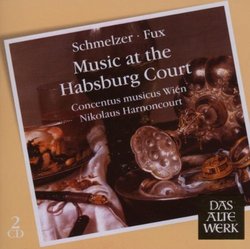| All Artists: Johann Heinrich Schmelzer, Johann Joseph Fux, Nikolaus Harnoncourt, Concentus Musicus Vienna Title: Music at the Habsburg Court (Schmelzer, Fux) Members Wishing: 0 Total Copies: 0 Label: Warner: Das Alte Werk Release Date: 11/12/2007 Album Type: Import Genre: Classical Style: Number of Discs: 2 SwapaCD Credits: 2 UPCs: 0825646985241, 825646985241 |
Search - Johann Heinrich Schmelzer, Johann Joseph Fux, Nikolaus Harnoncourt :: Music at the Habsburg Court (Schmelzer, Fux)
 | Johann Heinrich Schmelzer, Johann Joseph Fux, Nikolaus Harnoncourt Music at the Habsburg Court (Schmelzer, Fux) Genre: Classical |
Larger Image |
CD Details |
CD ReviewsClassy Re-release from Vienna with Baroque Music Which Deser Leslie Richford | Selsingen, Lower Saxony | 06/13/2009 (5 out of 5 stars) "Music at the Habsburg Court (2 CDs): CD 1: Johann Heinrich Schmelzer (c. 1620/23 - 1680): Sonata Natalitia a 3 Chori; Sonata II a 8, due chori; Sonata a 4 "La Caroletta"; Sonata I a 8; Sonata a 3; Sonata IV a 6; Sonata a 5; Sonata a 3; Sonata a 3 Violini.
CD 2: Johann Joseph Fux (1660 - 1740): Serenada a 8; Rondeau a 7; Sonata a Quattro. Performed by the Concentus Musicus Wien [Vienna]. Recorded in 1969 and 1970 at the Casino Zögernitz, Vienna [Austria]. Originally released on LP by Teldec. This release (2564-69852-4; LC 04281) by Warner Classics and Jazz 2007. Total playing time: 96'34". Warner is currently celebrating 50 years of its "Das Alte Werk" series with music from the Middle Ages through to the Baroque performed on period instruments. Some of the most impressive recordings from this era are being re-released in superior packaging (Super-Audio jewel box, impressive cover art, thin but informative booklets with information about the individual musicians involved). The current issue "Music at the Habsburg Court" is currently also available as two separate CDs on Warner's "Apex" label, but the "Alte Werk" edition has the said advantage of the packaging, with a complete listing of the musicians involved (although it seems that the trombonists have been confused with the trumpeters) and an introductory essay which, while rather short, does enable a more intellectually informed listening. Schmelzer was, together with Heinrich Ignaz Franz von Biber, one of the most famous 17th century composers in Vienna bzw. Kromeriz. His "Sacro-profanus concentus musicus" of 1662, from which three of the nine pieces on CD 1 are taken (the dedication is printed as a facsimile in the booklet), contains some of his most famous "trumpet music" (title of Philip Pickett's recording of some of these works), but it would be too simple to class these works as "fanfares": they are scored not only for clarino trumpet, but also for trombones, cornet, dulcian, chalumeau and strings (violin, viola, gamba, violone), with a harpsichord or an organ as an additional bass foundation. The 40 year old recording with its amazingly clear and noiseless engineering makes listening to the sound of these ancient instruments a delight, and even the somewhat "angular"-sounding violins cannot diminish the pleasure one feels at hearing these pioneering performances of music which deserves to be much better known than it is. Three of the recorded pieces, incidentally, are for strings only, without the trumpets and trombones. Johann Joseph Fux also served at the Habsburg Court, but a generation later, his "Concentus musico-instrumentalis", from which the "Serenada a 8" is taken, having been published in 1701. The music sounds much "smoother" and generally a good deal more modern than the somewhat backward-looking sonatas by Schmelzer. The chalumeaux are now replaced by baroque oboes, and the strings play a more prominent role, although here, too, the brass has its wonderful highlights (compliments to Josef Spindler and Richard Rudolf; playing the clarino in 1969/1970 was quite an adventure and the fact that they managed to play in tune should not be taken for granted!). The "Serenada" consists, in fact, of three short suites of dance music, some of which sounds, with its dotted rhythms, more French than German. The two pieces which act as fillers, the Rondeau a 7 and the Sonata a Quattro, are also well worth the hearing. Nikolaus Harnoncourt has always been a somewhat controversial figure, but for those of us who love period instruments and historical performance practice he is something of a first-generation idol. Personally, I have immensely enjoyed these albeit rather short discs and feel encouraged to sample some more of Warner's classy re-releases from Vienna." |
